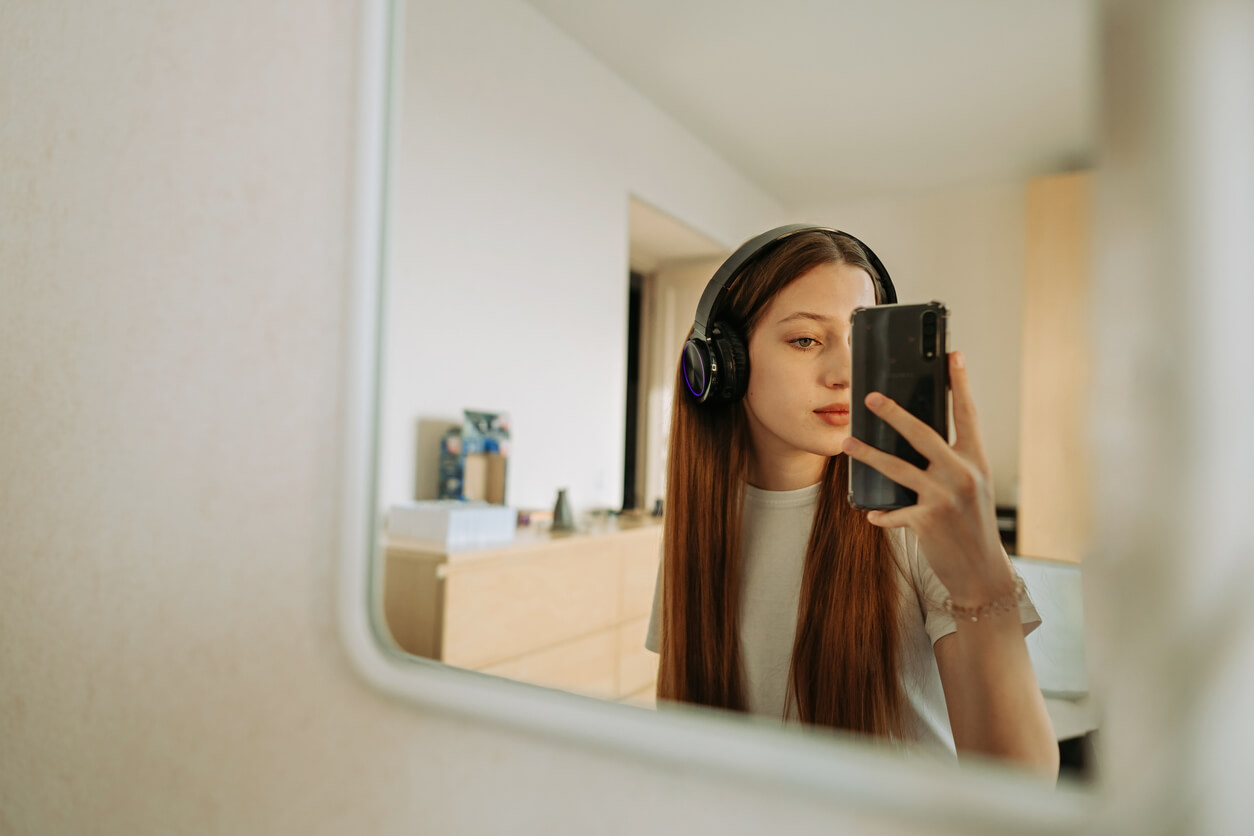BeReal, the New Social Network Used by Teenagers


Written and verified by the psychologist Elena Sanz Martín
Teenagers and social networks are two concepts that go hand in hand. Our young people spend much of their time posting and consuming content on the Internet. They explore profiles and participate in the fashion trends of the moment. However, just when we thought that everything had already been invented in this world, a new social network appeared on the scene. BeReal is an original and novel proposal that turns the rules of social media upside down.
Its goal is to be the antithesis of that halo of superficiality and perfection that dominates platforms like Instagram or TikTok. Here, there are no filters and there’s no planning. The idea is precisely to be real. And because of the unique approach of this new social network, it has become increasingly popular among teenagers. Therefore, if you have a child that uses social media, you’ll want to know all about BeReal.
What is BeReal?
As we’ve said, BeReal is a new social network that has become very fashionable among young people of the Z generation. In fact, it was created in 2020 by Frenchmen Alexis Barreyat and Kevin Perreau, but it was in 2022 that its popularity increased the most. The innovative concept is that this platform allows us to show and observe others in everyday moments, without editing the videos and without organizing anything in advance.
The dynamics are quite simple. To use BeReal, all you have to do is download the app (which is available for iOS and Android) and create a user account. Then the platform will send you a notification at a random time of the day (which you can’t predict) with the prompt “It’s time to BeReal.”

Posting options
At this point, users log into the social network and have two minutes to upload a picture of what they’re doing at that moment. The publication superimposes two images; one taken with the front camera (selfie style) and another with the rear camera, which shows the environment where the person is.
There’s also the option of publishing these images privately so that only your friends can see them, or publicly. In the latter case, anyone can discover you and see your posts. However, you can only access your friends’ content if you have previously published your own photos. Therefore, being a passive user and remaining in the shadows isn’t an option.
What differentiates BeReal from other social networks?
With the above information, you may have already realized some important differences between BeReal and some of the other most popular social networks among teenagers. Even so, here are the main differences.
Time of use
In applications such as TikTok, young people can spend hours on end scrolling, and that’s precisely the idea. In this network, the goal is to get users to spend as much time as possible on the platform, for which various strategies are used. In BeReal, on the other hand, the objective is for the time of use to be limited and for users to only see the real publications of the moment.
Reality vs. Fiction
This is the most outstanding feature, as here, there are no filters of any kind that can be used on the images. In addition, it’s also not possible to access the gallery to select previously taken pictures. The only option is to take an image on the spot and publish it as it is. It’s true that the app allows you to make several attempts, but other people will know how many you’ve used before selecting the final photograph.
With this, users are called to ground themselves in reality, to share and observe ordinary lives, ordinary bodies, and everyday situations. This relieves the pressure that’s created in other virtual environments by seeing perfectly prepared, retouched, and adulterated montages.

Freedom of movement
In BeReal, the user can’t publish whenever or as much as they want. They can only do it when the app allows them to do so. And this is once a day, after having received the notification. In addition, the user can’t review the profiles and posts of others if they haven’t uploaded their content that day. The rules are more limiting than in other social networks.
Duration of content
Finally, BeReal posts are deleted within 24 hours. This is something that also happens on other platforms with the option of stories, but on those platforms, it’s possible to share other content that remains permanently visible. Not here.
BeReal also has its risks
In short, the idea of BeReal is different and innovative, as it has interesting points in its favor. However, it’s not a perfect application. There are people who don’t use it correctly and, instead of uploading the image at the time they’re prompted to, they wait until they’re in a more “idyllic” situation to enter the application and publish. This leads us to lose the realism that’s intended.
At the same time, the fact that the notification comes randomly at some point in the day can cause users to be constantly attentive, waiting for the prompt, which isn’t positive. Just the same, it really is an interesting social network that your teenager will probably use or want to use. But, as in any other case, your guidance and supervision will be important.
Teenagers and social networks are two concepts that go hand in hand. Our young people spend much of their time posting and consuming content on the Internet. They explore profiles and participate in the fashion trends of the moment. However, just when we thought that everything had already been invented in this world, a new social network appeared on the scene. BeReal is an original and novel proposal that turns the rules of social media upside down.
Its goal is to be the antithesis of that halo of superficiality and perfection that dominates platforms like Instagram or TikTok. Here, there are no filters and there’s no planning. The idea is precisely to be real. And because of the unique approach of this new social network, it has become increasingly popular among teenagers. Therefore, if you have a child that uses social media, you’ll want to know all about BeReal.
What is BeReal?
As we’ve said, BeReal is a new social network that has become very fashionable among young people of the Z generation. In fact, it was created in 2020 by Frenchmen Alexis Barreyat and Kevin Perreau, but it was in 2022 that its popularity increased the most. The innovative concept is that this platform allows us to show and observe others in everyday moments, without editing the videos and without organizing anything in advance.
The dynamics are quite simple. To use BeReal, all you have to do is download the app (which is available for iOS and Android) and create a user account. Then the platform will send you a notification at a random time of the day (which you can’t predict) with the prompt “It’s time to BeReal.”

Posting options
At this point, users log into the social network and have two minutes to upload a picture of what they’re doing at that moment. The publication superimposes two images; one taken with the front camera (selfie style) and another with the rear camera, which shows the environment where the person is.
There’s also the option of publishing these images privately so that only your friends can see them, or publicly. In the latter case, anyone can discover you and see your posts. However, you can only access your friends’ content if you have previously published your own photos. Therefore, being a passive user and remaining in the shadows isn’t an option.
What differentiates BeReal from other social networks?
With the above information, you may have already realized some important differences between BeReal and some of the other most popular social networks among teenagers. Even so, here are the main differences.
Time of use
In applications such as TikTok, young people can spend hours on end scrolling, and that’s precisely the idea. In this network, the goal is to get users to spend as much time as possible on the platform, for which various strategies are used. In BeReal, on the other hand, the objective is for the time of use to be limited and for users to only see the real publications of the moment.
Reality vs. Fiction
This is the most outstanding feature, as here, there are no filters of any kind that can be used on the images. In addition, it’s also not possible to access the gallery to select previously taken pictures. The only option is to take an image on the spot and publish it as it is. It’s true that the app allows you to make several attempts, but other people will know how many you’ve used before selecting the final photograph.
With this, users are called to ground themselves in reality, to share and observe ordinary lives, ordinary bodies, and everyday situations. This relieves the pressure that’s created in other virtual environments by seeing perfectly prepared, retouched, and adulterated montages.

Freedom of movement
In BeReal, the user can’t publish whenever or as much as they want. They can only do it when the app allows them to do so. And this is once a day, after having received the notification. In addition, the user can’t review the profiles and posts of others if they haven’t uploaded their content that day. The rules are more limiting than in other social networks.
Duration of content
Finally, BeReal posts are deleted within 24 hours. This is something that also happens on other platforms with the option of stories, but on those platforms, it’s possible to share other content that remains permanently visible. Not here.
BeReal also has its risks
In short, the idea of BeReal is different and innovative, as it has interesting points in its favor. However, it’s not a perfect application. There are people who don’t use it correctly and, instead of uploading the image at the time they’re prompted to, they wait until they’re in a more “idyllic” situation to enter the application and publish. This leads us to lose the realism that’s intended.
At the same time, the fact that the notification comes randomly at some point in the day can cause users to be constantly attentive, waiting for the prompt, which isn’t positive. Just the same, it really is an interesting social network that your teenager will probably use or want to use. But, as in any other case, your guidance and supervision will be important.
All cited sources were thoroughly reviewed by our team to ensure their quality, reliability, currency, and validity. The bibliography of this article was considered reliable and of academic or scientific accuracy.
- Su C, Zhou H, Gong L, Teng B, Geng F, Hu Y. Viewing personalized video clips recommended by TikTok activates default mode network and ventral tegmental area. Neuroimage. 2021;237:118136. doi:10.1016/j.neuroimage.2021.118136
- Wilmer, H. H., & Chein, J. M. (2016). Mobile technology habits: patterns of association among device usage, intertemporal preference, impulse control, and reward sensitivity. Psychonomic bulletin & review, 23(5), 1607-1614.
This text is provided for informational purposes only and does not replace consultation with a professional. If in doubt, consult your specialist.








